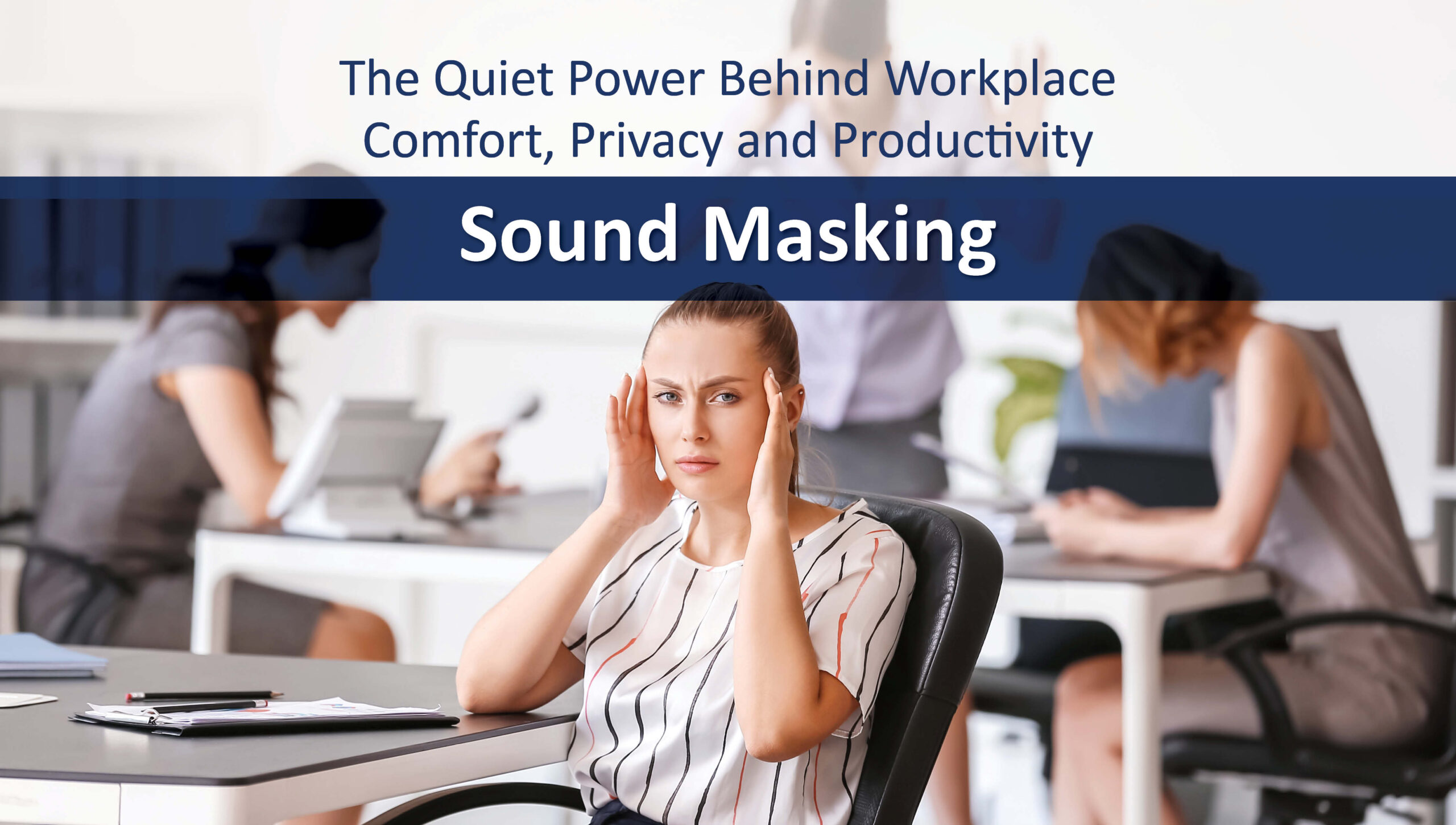Sound Masking: The Quiet Power Behind Workplace Comfort, Privacy, and Productivity

In today’s fast-paced work environments—whether you’re in a bustling open office, a hybrid workspace, or a healthcare facility—what you hear has a huge impact on your experience. It can be a major source of distraction, stress, and even compliance risk. That’s why more organizations are turning to sound masking as a smart, scalable solution to create better acoustic environments.
So, what exactly is sound masking? Is it like the sound machines used to help babies sleep? Sound masking is the process of adding carefully engineered sound—subtle and specifically tuned to the frequencies of human speech—that helps make conversations less intelligible to unintended listeners. This makes it easier for people to concentrate, collaborate, and communicate without the constant interruptions caused by overheard chatter.
The science behind sound masking is called auditory masking, where the brain’s ability to hear one sound is affected by the presence of another. Now, you might be wondering how this differs from the popular auditory masking terms, white noise or pink noise. White noise is a random signal that contains equal intensity across all frequencies, which can sound harsh or static-like. Pink noise, on the other hand, emphasizes lower frequencies and is often perceived as more natural and soothing—like rainfall or wind rustling through trees. While both can be used for masking sound, true sound masking systems go a step further by targeting the specific frequency range of human speech (typically between 100 Hz and 5 kHz), making them far more effective and comfortable for long-term use.
The reasons organizations implement sound masking often boil down to four key benefits: comfort, productivity, privacy, and compliance. It creates a more pleasant and consistent audio environment, which helps reduce cognitive fatigue and stress. Employees can stay focused longer, make fewer errors, and feel less mentally drained by the end of the day. In sensitive environments like healthcare, finance, and HR, sound masking also plays a critical role in protecting speech privacy and meeting regulatory requirements like HIPAA.
Modern sound masking systems are incredibly flexible. They can be zoned to suit different areas of a workspace—like collaborative zones, quiet zones, or private offices. They’re programmable, allowing adjustments based on time of day or activity levels, and they can be easily controlled to meet the changing needs of a dynamic office.

The Impact of Noise—and Silence—on Workplace Well-Being
We often talk about the dangers of too much noise in the workplace. Loud HVAC systems, ringing phones, and constant chatter can reduce cognitive performance by up to 66%, increase stress levels, and lead to burnout. But what’s less commonly discussed is the downside of spaces that are too quiet.
In environments where silence dominates—like certain private offices, libraries, or underutilized meeting rooms—every sound becomes amplified. A single conversation, keyboard click, or footstep can feel intrusive and distracting. This hyper-awareness of sound can actually increase anxiety and make people hesitant to speak freely, especially when discussing sensitive topics.
Too quiet of a space can also create a sense of isolation, which is counterproductive in collaborative or client-facing settings. Employees may feel disconnected or uncomfortable, and the lack of ambient sound can make interactions feel awkward or unnatural.
Sound masking helps strike the right balance. It fills the acoustic void with a gentle, unobtrusive background sound that reduces the contrast between silence and sudden noise. This not only improves comfort but also encourages natural communication and reduces the psychological tension that can come from working in overly quiet environments.
Sound Masking and the WELL Building Standard
As organizations place greater emphasis on employee well-being, many are aligning their spaces with the WELL Building Standard™—a globally recognized framework for designing buildings that support human health and performance. As described in WELL Building Standard™ version 2 (WELL v2), the Sound concept “aims to bolster occupant health and well-being through the identification and mitigation of acoustical comfort parameters that shape occupant experiences in the built environment.” Sound masking plays a vital role in meeting these criteria by reducing unwanted noise and enhancing speech privacy. It helps create environments where people can focus without distraction, communicate without concern, and feel more at ease throughout the day. By integrating sound masking into your building’s design, you’re not only improving acoustics—you’re actively contributing to a healthier, more supportive workplace that meets WELL certification goals. If choosing to pursue certification, working with a sound masking system granted the Works with Well license by The International WELL Building Institute™ (IWBI™) is a good way to ensure requirements can be met.

Real-World Impact: A Healthcare Use Case
Consider a multi-physician family practice located in a shared medical office building. The clinic faced a common challenge: patients and staff could overhear confidential conversations at check-in desks, through exam room walls, and in hallways. This not only made patients uncomfortable but also raised serious concerns about HIPAA compliance.
Solution:
By installing a sound masking system with direct-field emitters in ceiling tiles and configuring zones to match the layout and ambient noise levels, the clinic was able to dramatically improve privacy and comfort. The solutions included an integrated control panel for adjusting volume levels based on daily activity. Staff could speak freely, patients felt more secure, and the overall atmosphere became more professional and calming.
Getting It Right
It’s important to note that not all sound masking systems are created equal. To be truly effective, a system must be capable of producing a full frequency spectrum from 100 Hz to 5 kHz. Many emitters on the market are too small to reach the lower frequencies needed for occupant comfort and comprehensive masking. That’s why working with experienced A/V professionals and conducting an acoustic audit is essential to achieving the desired results.
Simply installing a sound masking system doesn’t ensure success. The sound has to be tuned to meet a particular spectrum—a ‘curve’ that’s engineered to maximize acoustic control, while not sacrificing occupant comfort. A masking system can’t achieve this goal ‘out of the box.’ After it’s installed, its output has to be tuned by a qualified technician, who measures the sound and adjusts it as needed until the curve is consistently met throughout your space. Ask your masking vendor or acoustician for a post-installation tuning report that shows the results they achieved within all treated areas
At OneVoice Communications, we understand that sound isn’t just something you hear—it’s something you feel. Whether you’re designing a new office, upgrading a healthcare facility, or supporting a hybrid workforce, we can help you implement sound masking solutions that enhance privacy, productivity, and well-being—without making your space too loud or too quiet.
